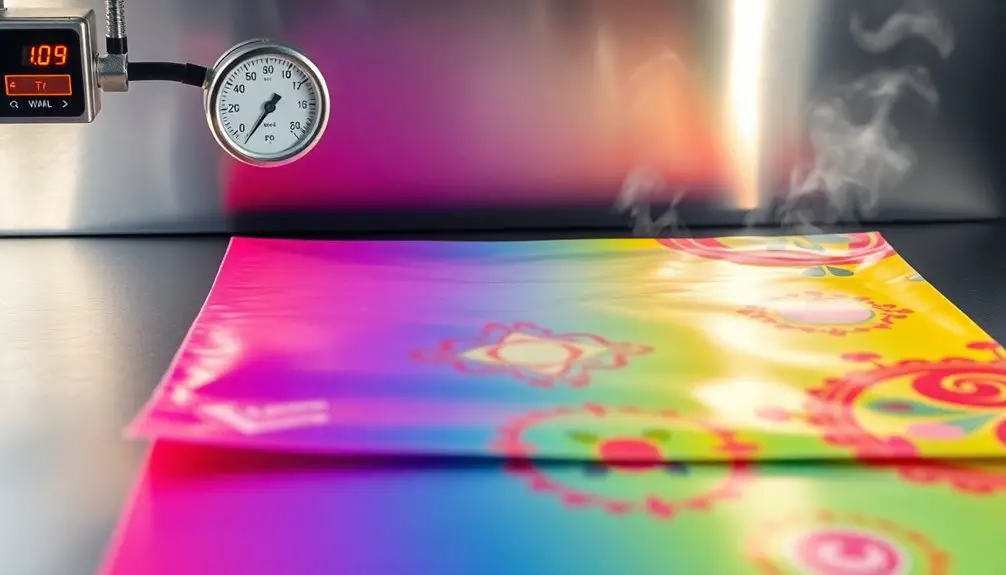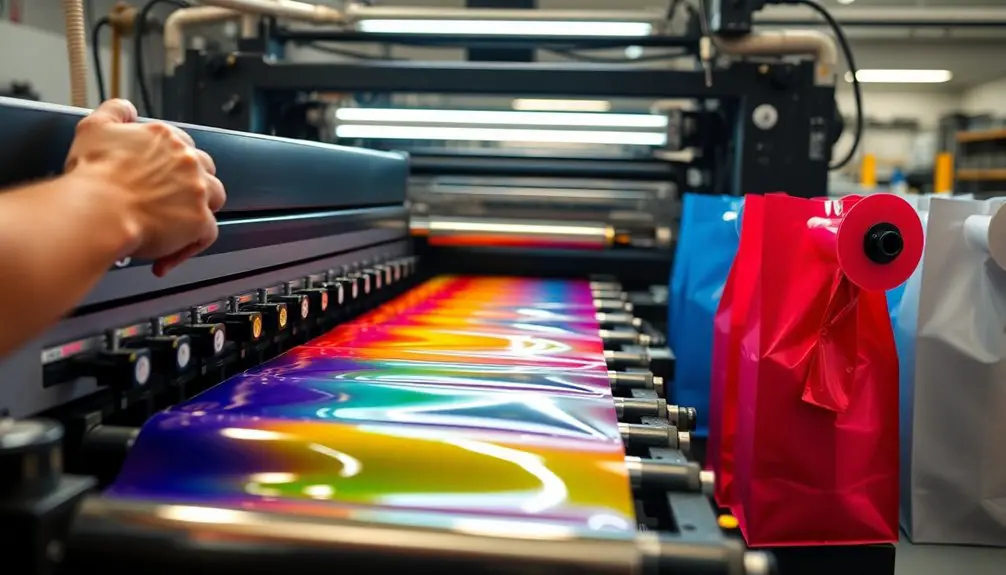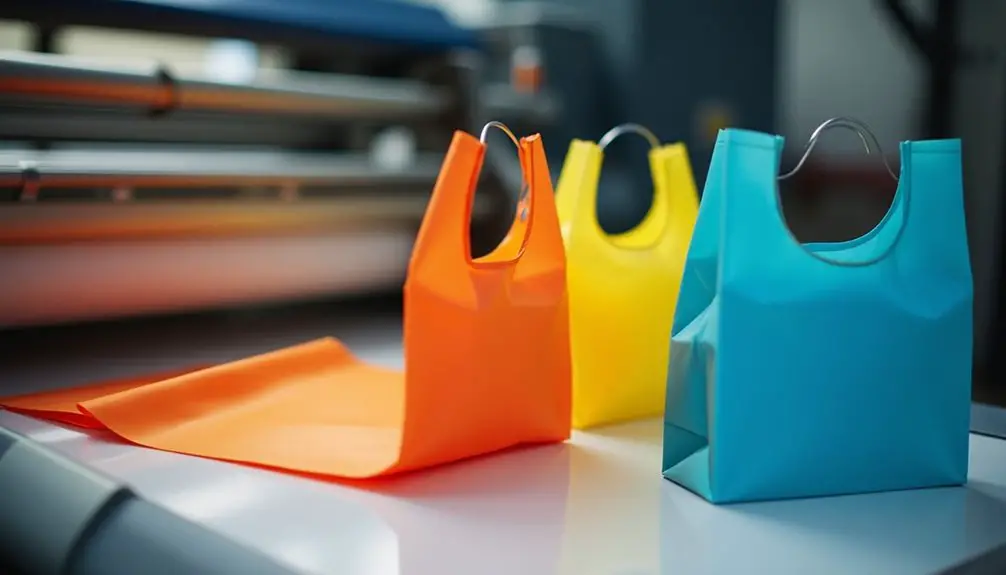Printing on polypropylene bags is straightforward and eco-friendly. Start by using low-temperature transfer methods, ideally between 275°F and 285°F. Incorporate low cure additives in your ink mix for better adhesion and maintain a consistent ink mix of 6% by weight. Ensure even pressure by using a Print Perfect Pad for application. Monitor your curing conditions closely to prevent damage; avoid exceeding 400°F. With these strategies, your prints will look great and stick well. For more tips and techniques to perfect your printing process, you won't want to miss what comes next!
Key Takeaways
- Use low-temperature transfer methods (275-285°F) to effectively print on polypropylene bags without damaging them.
- Incorporate low cure additives in the ink mix to enhance performance at reduced temperatures.
- Maintain a consistent ink mix by using a recommended 6% by weight for optimal adhesion and quality.
- Regularly monitor curing conditions to avoid exceeding 400°F, which can compromise the bags' structure.
- Experiment with equipment settings and ink combinations to achieve the best results for your specific setup.
Understanding Polypropylene Bags
Understanding polypropylene bags starts with recognizing their eco-friendly nature and versatility. These bags are designed to be reusable, which helps reduce plastic waste in retail settings. As a consumer, you'll appreciate their environmentally friendly attributes, especially if you're eco-conscious.
Polypropylene bags are commonly used for promotional purposes, making them a popular choice for trade show giveaways and enhancing brand visibility. Their durability allows them to endure various applications, from retail environments to corporate functions.
You'll find that these bags can be customized through various printing methods, boosting brand recognition effectively.
What makes polypropylene bags even more appealing is their adaptability across different industries. Whether you're attending an event or simply shopping at your favorite store, these bags cater to your needs while promoting sustainability.
By adopting these bags, businesses can significantly contribute to reducing the estimated 17 million tonnes of plastic waste projected to enter oceans by 2025, while also enhancing their brand image.
Essential Printing Techniques
When it comes to printing on polypropylene bags, selecting the right techniques is key to achieving high-quality results. Start by utilizing low-temperature transfer methods, ideally around 275-285°F. This ensures the integrity of your bags during the printing process.
It's also essential to incorporate a low cure additive like 3804 into your ink mix. This additive helps you achieve optimal results without damaging the bags.
For efficiency and consistent application, maintain a recommended ink mix of 6% by weight. This balance not only enhances the print quality but also ensures that the ink adheres properly.
Use the Print Perfect Pad to improve application quality further. This tool guarantees even pressure distribution when transferring designs onto the bags, resulting in a professional finish.
Lastly, keep a close eye on curing conditions. Excessive heat from flash curing stages can exceed 400°F, which risks both bag integrity and print quality.
Managing Temperature Effectively

Managing temperature effectively during the printing process is crucial for maintaining the integrity of polypropylene bags. The typical plastisol curing temperature for these bags is around 320°F, but you can use low cure additives to achieve effective curing at reduced temperatures of 275-285°F. This can help you avoid damaging the material.
Remember, polypropylene's melting point is approximately 300°F, so lower dryer temperatures are essential to prevent melting.
Be vigilant about monitoring the curing process. Flash units can reach temperatures exceeding 400°F, which can compromise the bag's structure. You don't want to risk the quality of your prints by exposing the bags to excessive heat.
Consistent testing and adjustments to your dryer settings are essential to determine the optimal curing conditions for your specific printing setup.
Also, note that the thermal resistance of polypropylene is generally higher than PVC temperature limits, allowing it to handle higher temperatures.
Ink Application Strategies
To achieve optimal results in ink application on polypropylene bags, you'll want to focus on a few key strategies. Start by using a recommended ink mix at 6% by weight. This ensures the right consistency and performance for your prints. Before you apply the ink, make sure to mix it thoroughly; a uniform texture will prevent inconsistencies during printing.
Pay close attention to the flash curing stage. Excessive heat from flash units can exceed 400°F, which could damage the bag or affect ink adhesion. To mitigate this risk, incorporate a low cure additive in your ink formulation. This allows you to cure at lower temperatures, typically around 275-285°F, helping to preserve the integrity of the polypropylene material.
Lastly, don't skip regular testing and experimentation with your curing conditions. Each dryer and ink combination is unique, so take the time to find the best settings. This diligence will help you achieve high-quality results that meet your expectations.
Equipment Adjustments and Tips

Optimizing your equipment settings is crucial for successful printing on polypropylene bags. Start by adjusting your dryer settings to a lower temperature, ideally between 275°F and 285°F. This range effectively cures inks without damaging the polypropylene material.
Consider using a low cure additive like 3804 to enhance ink performance, allowing for optimal results at these reduced curing temperatures.
Regularly test and tweak your equipment settings, as different electric dryers may have varying operational parameters that influence the curing process. It's essential to ensure thorough mixing of the ink, aiming for a recommended 6% by weight. This consistency leads to effective curing on the bags.
Pay close attention to the flash curing stage, as excessive heat from flash units can exceed 400°F, which could damage the polypropylene. By monitoring this closely, you can prevent potential issues and ensure high-quality prints.
Frequently Asked Questions
How to Print on Polypropylene Bags?
To print on polypropylene bags, use a low-temperature transfer method around 275-285°F. Mix 6% of a low cure additive with your ink, ensuring even application for consistent, high-quality results. Regularly test dryer settings for optimal curing.
What Ink Sticks to Polypropylene?
To ensure ink sticks to polypropylene, use 900 series ink, particularly 901 White. Incorporate a low cure additive for better adhesion, and mix it properly to achieve the right consistency for optimal results.
Can You Print Onto Polypropylene?
Yes, you can print onto polypropylene. Just ensure you use the right ink and manage the temperature carefully. Proper preparation will help you achieve vibrant, durable prints without damaging the material.
Can You Heat Press a Polypropylene Bag?
Yes, you can heat press a polypropylene bag, but keep the temperature low to avoid damage. Monitor your settings closely, and consider using a Print Perfect Pad for better pressure distribution during the process.

